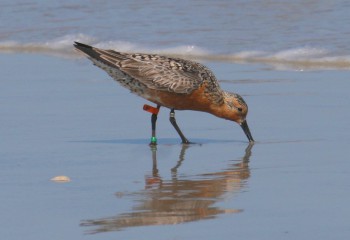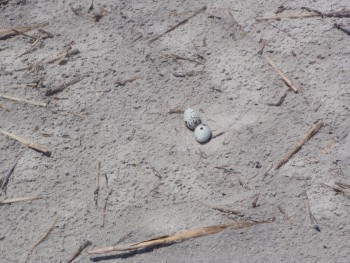
Red Knots are one of the bird species that rest at Rich Inlet as they travel north. Photo by Sam Bland
Imagine yourself on a long highway trip without the opportunity to rest before the next leg of your journey. Just as rest stops along our highways offer that chance, our coastal inlets provide critical resting habitats to the thousands of shorebirds traveling north and south to their nesting grounds each spring. Not only are our inlets necessary for these fragile creatures to recharge their energy stores, they also provide critical habitat for nesting and rearing their young. Every April, May and June, our inlets are alive with epic journeys and frenzied mating rituals that offer us all a glimpse into the lives of these long-traveled wanderers of the sky.
Red Knots appear at North Carolina inlets in April and May, and at Rich Inlet in Topsail, flocks of nearly 300 passed through on their way north. These flocks are making their way to their Arctic breeding grounds from wintering sites in southern Chile and Argentina, a one-way journey of over 9,000 miles. Individual knots have been tracked making non-stop flights from Brazil to the southeastern U.S. coast. However, Red Knots are federally listed as threatened under the Endangered Species Act due to habitat loss and other threats at migratory stopover sites.
Inlets also provide critical stops for many other species of migrating shorebirds during the spring months. This year, large flocks of more than 1,000 Semipalmated Plovers and Semipalmated Sandpipers arrived in May. Most are already gone, having departed for nesting sites in the Arctic after refueling and resting at North Carolina’s inlets.

Some eggs, such as those of the Least Tern pictured here, may be difficult to spot, so it is important to watch your step.
Not all birds that use inlets are just passing through. Plovers, terns and skimmers all nest at inlets. They require open, sandy areas for nesting, and natural, unstabilized spits at inlets provide ideal habitat. Least Terns began nesting in mid- to late April, and Black Skimmers started in mid-May. These birds, along with Common Terns, Wilson’s Plovers and Piping Plovers, will be raising chicks through August.
Don’t miss your chance to see the wonders of our coast at our inlets. Many nests are just small depressions in the sand with camouflaged eggs and are easy to step on. But if you go, remember to tread lightly and observe from a respectful distance to avoid disturbing the habitat of the migratory birds.
